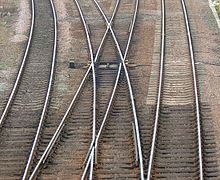
A bogie is a chassis or framework that carries a wheelset, attached to a vehicle—a modular subassembly of wheels and axles. Bogies take various forms in various modes of transport. A bogie may remain normally attached or be quickly detachable ; it may contain a suspension within it, or be solid and in turn be suspended ; it may be mounted on a swivel, as traditionally on a railway carriage or locomotive, additionally jointed and sprung, or held in place by other means.

A railroad switch (AE), turnout, or [set of] points (BE) is a mechanical installation enabling railway trains to be guided from one track to another, such as at a railway junction or where a spur or siding branches off.
Rail terminology is a form of technical terminology. The difference between the American term railroad and the international term railway is the most significant difference in rail terminology. These and other terms have often originated from the parallel development of rail transport systems in different parts of the world. In English-speaking countries outside the United Kingdom, a mixture of US and UK terms may exist.
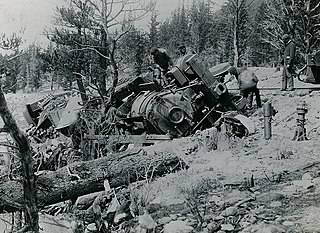
In rail transport, a derailment occurs when a rail vehicle such as a train comes off its rails. Although many derailments are minor, all result in temporary disruption of the proper operation of the railway system and they are a potentially serious hazard.

A draisine is a light auxiliary rail vehicle, driven by service personnel, equipped to transport crew and material necessary for the maintenance of railway infrastructure.

Facing or trailing are railway turnouts in respect to whether they are divergent or convergent. When a train traverses a turnout in a facing direction, it may diverge onto either of the two routes. When travelled in a trailing direction, the two routes converge onto each other.

An adhesion railway relies on adhesion traction to move the train. Adhesion traction is the friction between the drive wheels and the steel rail. The term "adhesion railway" is used only when it is necessary to distinguish adhesion railways from railways moved by other means, such as by a stationary engine pulling on a cable attached to the cars or by railways that are moved by a pinion meshing with a rack.
A wheel speed sensor (WSS) or vehicle speed sensor (VSS) is a type of tachometer. It is a sender device used for reading the speed of a vehicle's wheel rotation. It usually consists of a toothed ring and pickup.
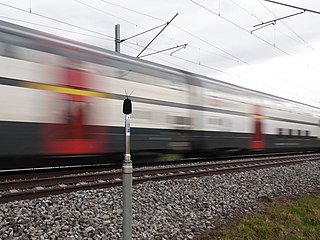
Train noise is vehicle noise created by trains. Noises may be heard inside the train and outside.
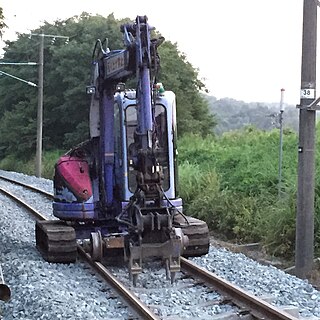
A road–rail vehicle or a rail–road vehicle is a dual-mode vehicle which can operate both on rail tracks and roads. They are also known as two-way vehicles, hi-rail, and rail and road vehicles.

A level junction is a railway junction that has a track configuration in which merging or crossing railroad lines provide track connections with each other that require trains to cross over in front of opposing traffic at grade.

A double junction is a railway junction where a double-track railway splits into two double track lines. Usually, one line is the main line and carries traffic through the junction at normal speed, while the other track is a branch line that carries traffic through the junction at reduced speed.

An axle counter is a system used in railway signalling to detect the clear or occupied status of a section of track between two points. The system generally consists of a wheel sensor and an evaluation unit for counting the axles of the train both into and out of the section. They are often used to replace a track circuit.
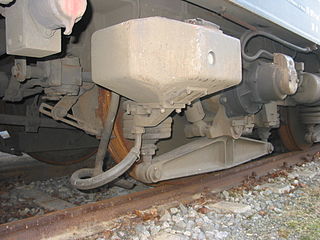
A sandbox is a container on most locomotives, multiple units and trams that holds sand, which is dropped on the rail in front of the driving wheels in wet and slippery conditions and on steep grades to improve traction.
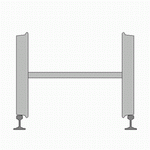
Hunting oscillation is a self-oscillation, usually unwanted, about an equilibrium. The expression came into use in the 19th century and describes how a system "hunts" for equilibrium. The expression is used to describe phenomena in such diverse fields as electronics, aviation, biology, and railway engineering.
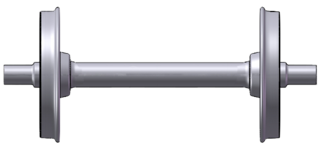
A wheelset is a pair of railroad vehicle wheels mounted rigidly on an axle such that both wheels rotate in unison. Wheelsets are often mounted in a bogie – a pivoted frame assembly holding at least two wheelsets – at each end of the vehicle. Most modern freight cars and passenger cars have bogies each with two wheelsets, but three wheelsets are used in bogies of freight cars that carry heavy loads, and three-wheelset bogies are under some passenger cars. Four-wheeled goods wagons that were once near-universal in Europe and Great Britain and their colonies have only two wheelsets; in recent decades such vehicles have become less common as trainloads have become heavier.

In automobiles, the axle track is the distance between the hub flanges on an axle. Wheel track, track width or simply track refers to the distance between the centerline of two wheels on the same axle. In the case of an axle with dual wheels, the centerline of the dual wheel assembly is used for the wheel track specification. Axle and wheel track are commonly measured in millimetres or inches.
A railway or railroad is a track where the vehicle travels over two parallel steel bars, called rails. The rails support and guide the wheels of the vehicles, which are traditionally either trains or trams. Modern light rail is a relatively new innovation which combines aspects of those two modes of transport. However fundamental differences in the track and wheel design are important, especially where trams or light railways and trains have to share a section of track, as sometimes happens in congested areas.

A flange-bearing frog, often abbreviated FBF, is a type of frog in which the flange of the wheel on a railway vehicle supports the weight of the vehicle. In conventional practice, the tread of the wheel rests on the head of the rail and bears the weight of the vehicle, while the flange is used to keep the vehicle in the gauge of the track. Modern flange-bearing frogs for use in freight railroad applications are a relatively recent development as a means to reduce maintenance costs associated with turnouts and diamonds, where rails must cross one another.

A train wheel or rail wheel is a type of wheel specially designed for use on railway tracks. The wheel acts as a rolling component, typically press fitted onto an axle and mounted directly on a railway carriage or locomotive, or indirectly on a bogie, also called a truck. The powered wheels under the locomotive are called driving wheels. Wheels are initially cast or forged and then heat-treated to have a specific hardness. New wheels are machined using a lathe to a standardized shape, called a profile, before being installed onto an axle. All wheel profiles are regularly checked to ensure proper interaction between the wheel and the rail. Incorrectly profiled wheels and worn wheels can increase rolling resistance, reduce energy efficiency and may even cause a derailment. The International Union of Railways has defined a standard wheel diameter of 920 mm (36 in), although smaller sizes are used in some rapid transit railway systems and on ro-ro carriages.




